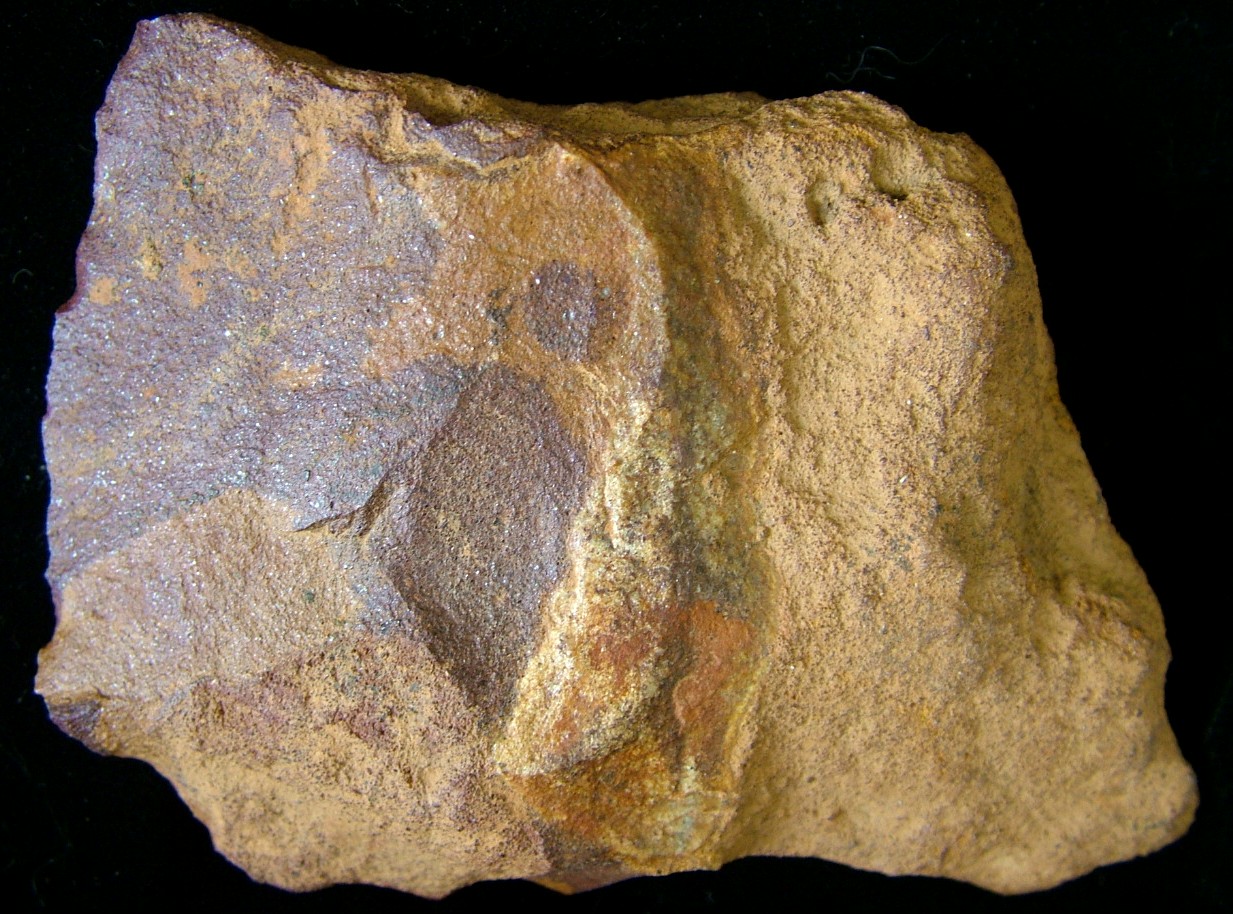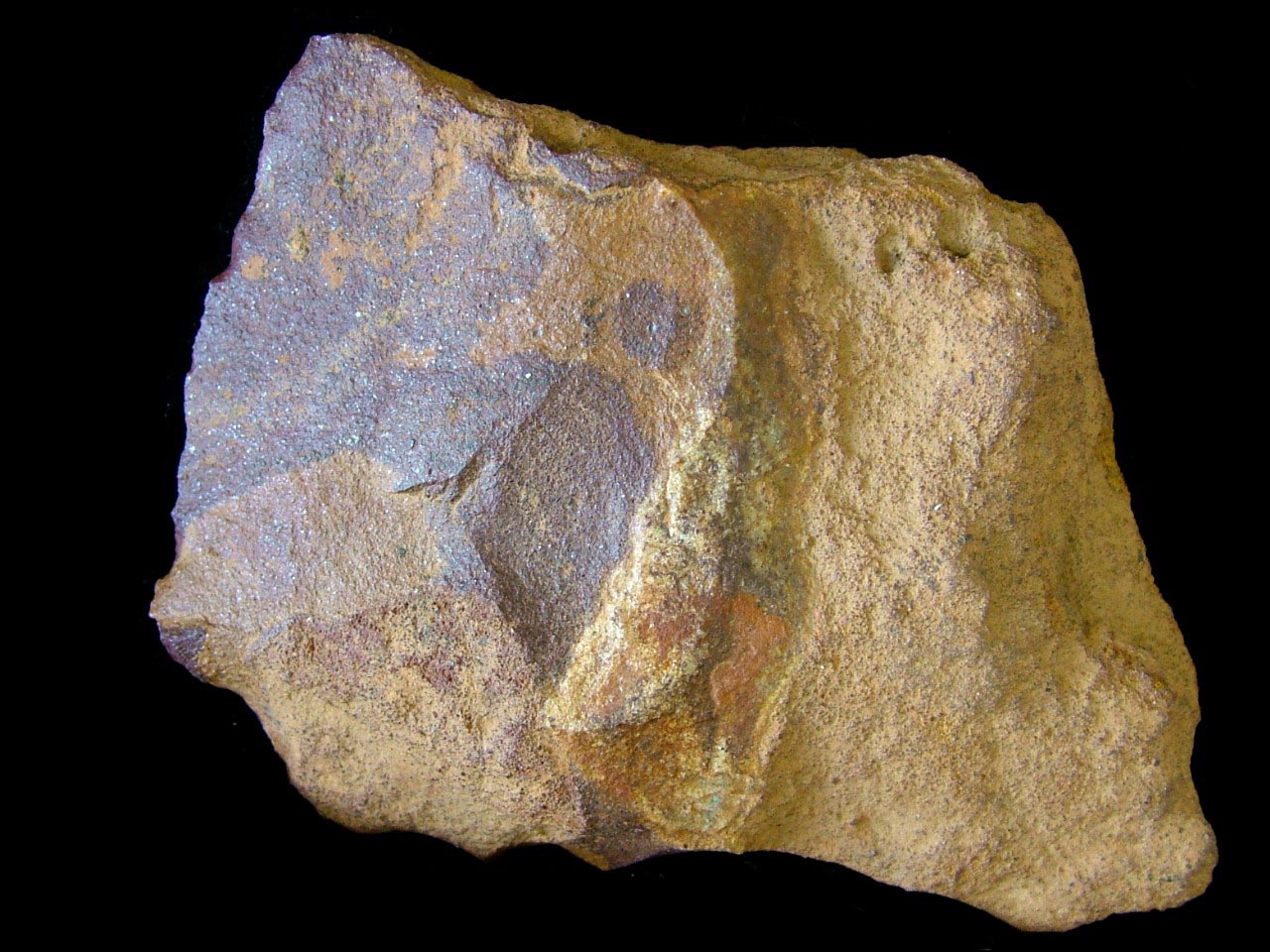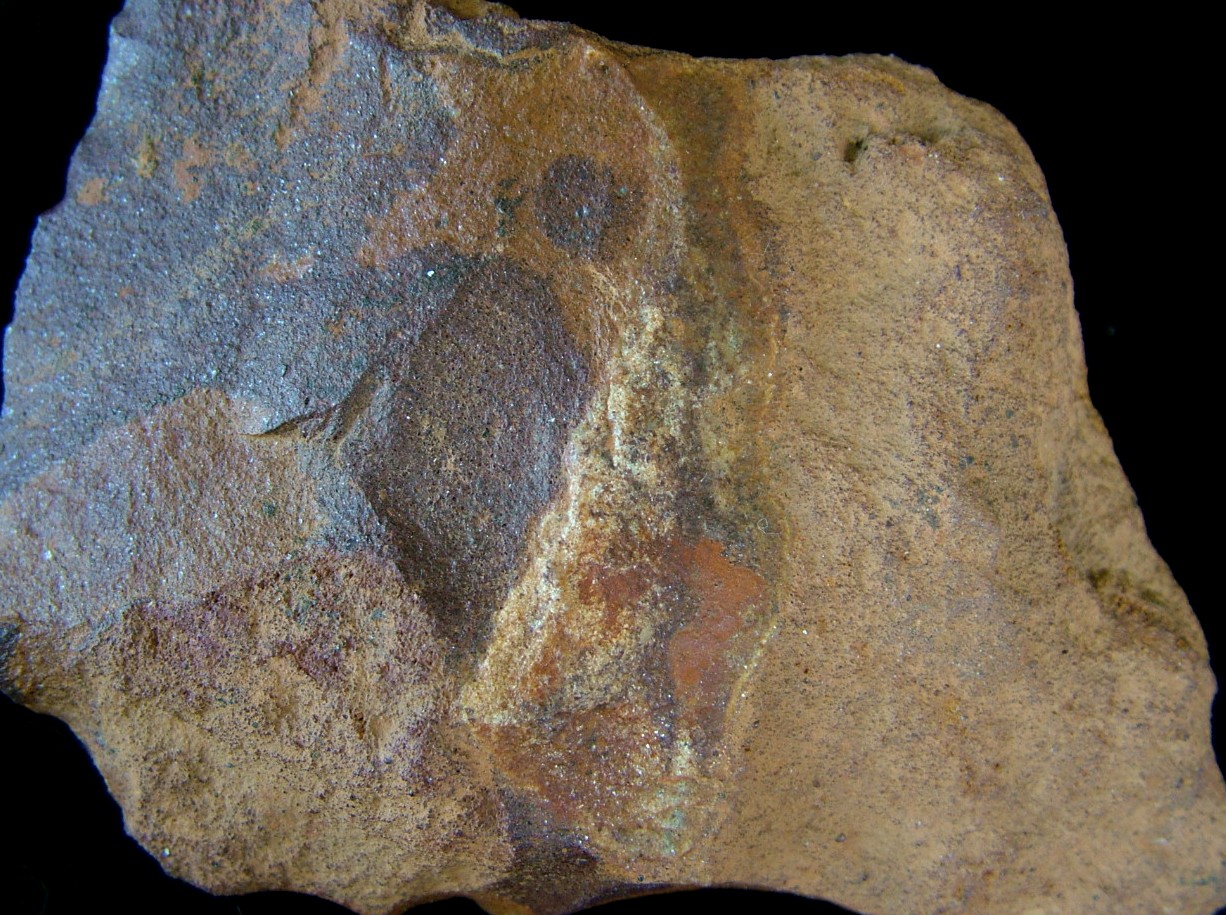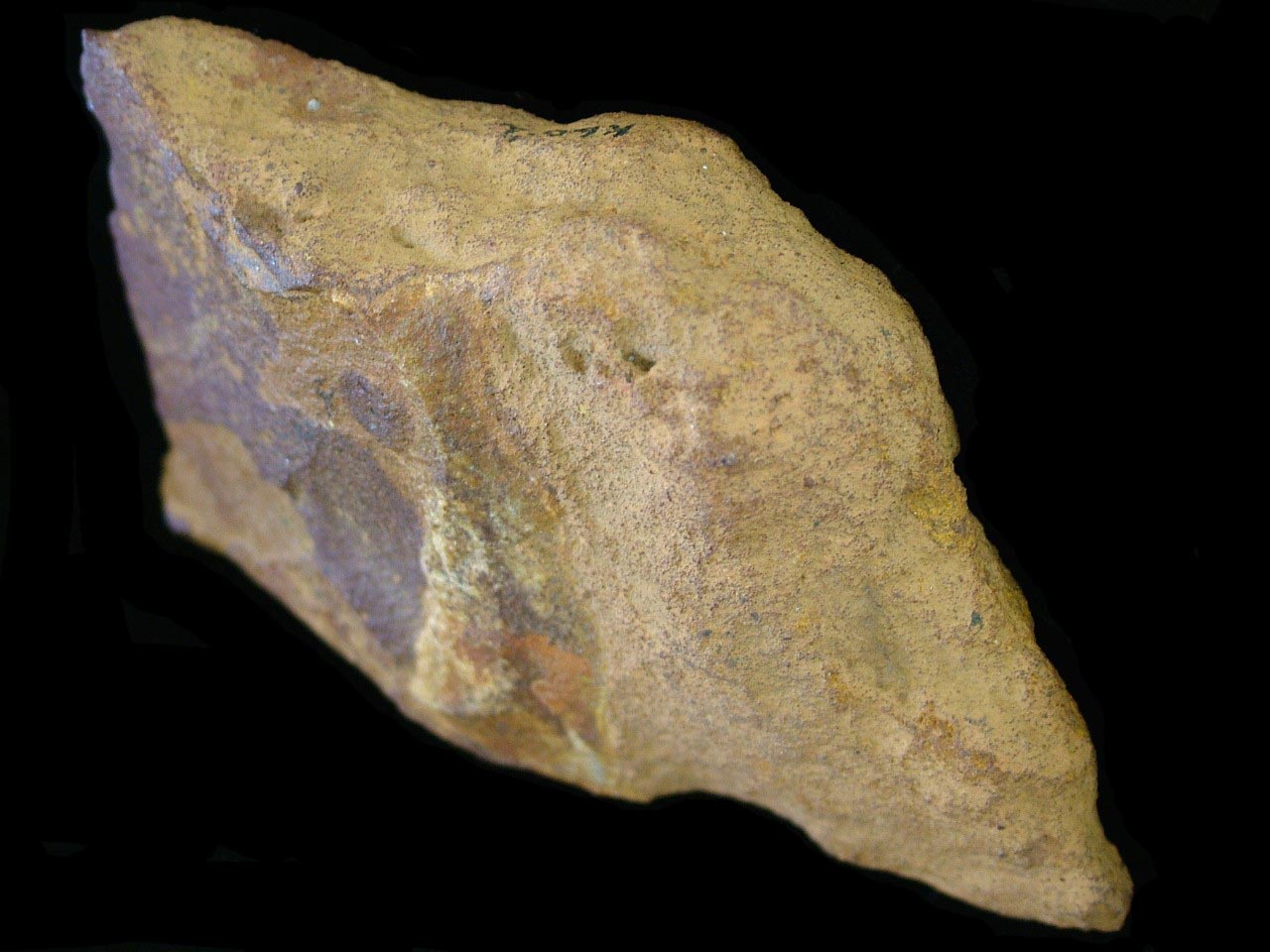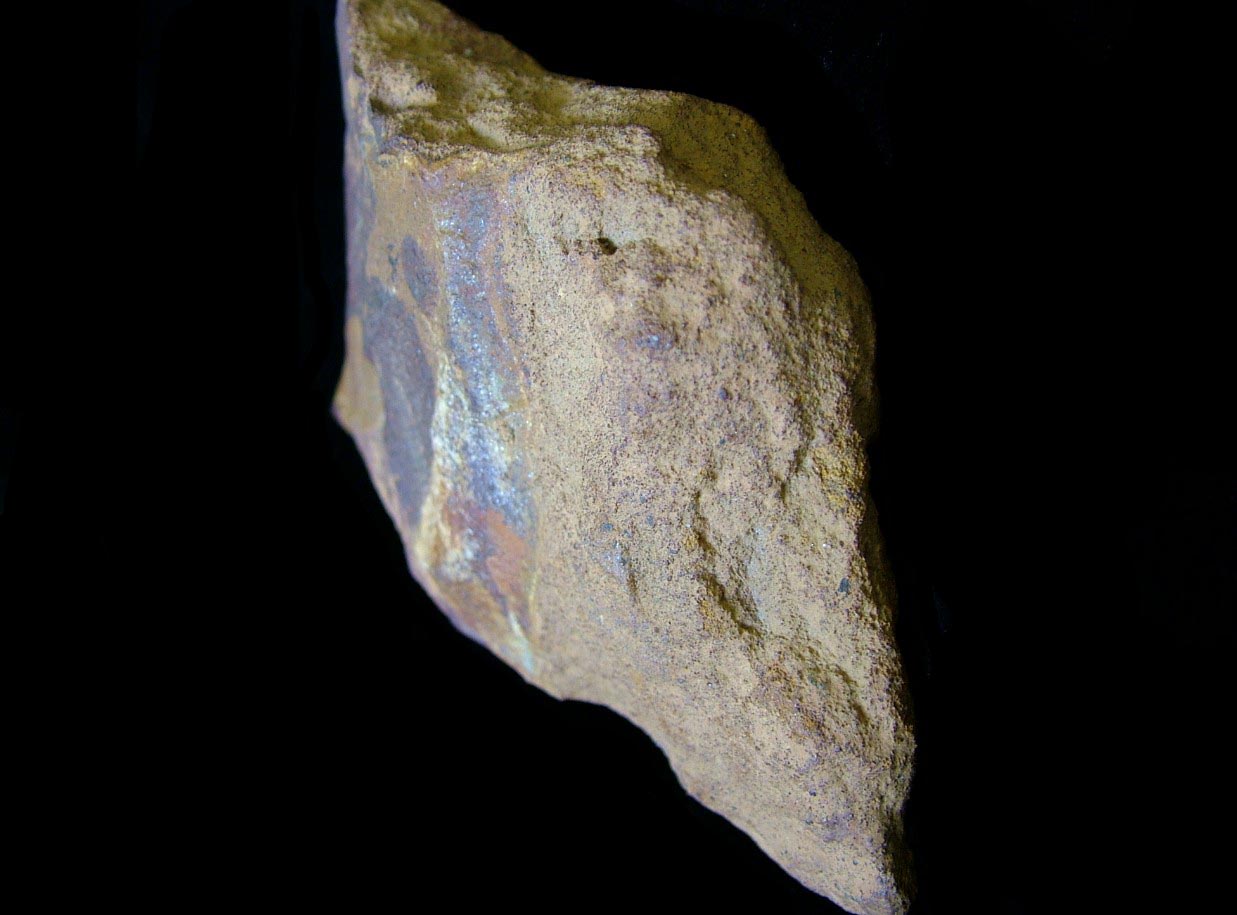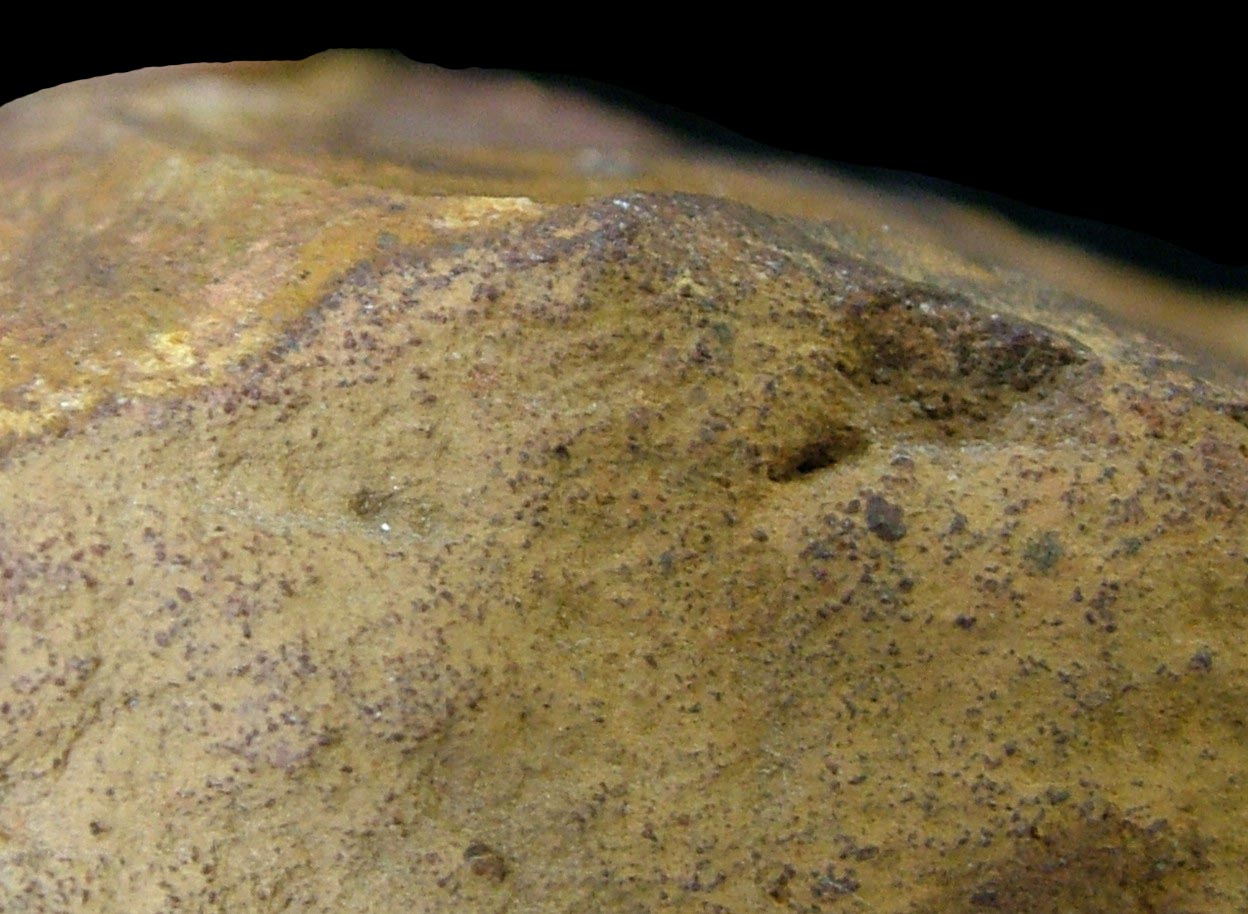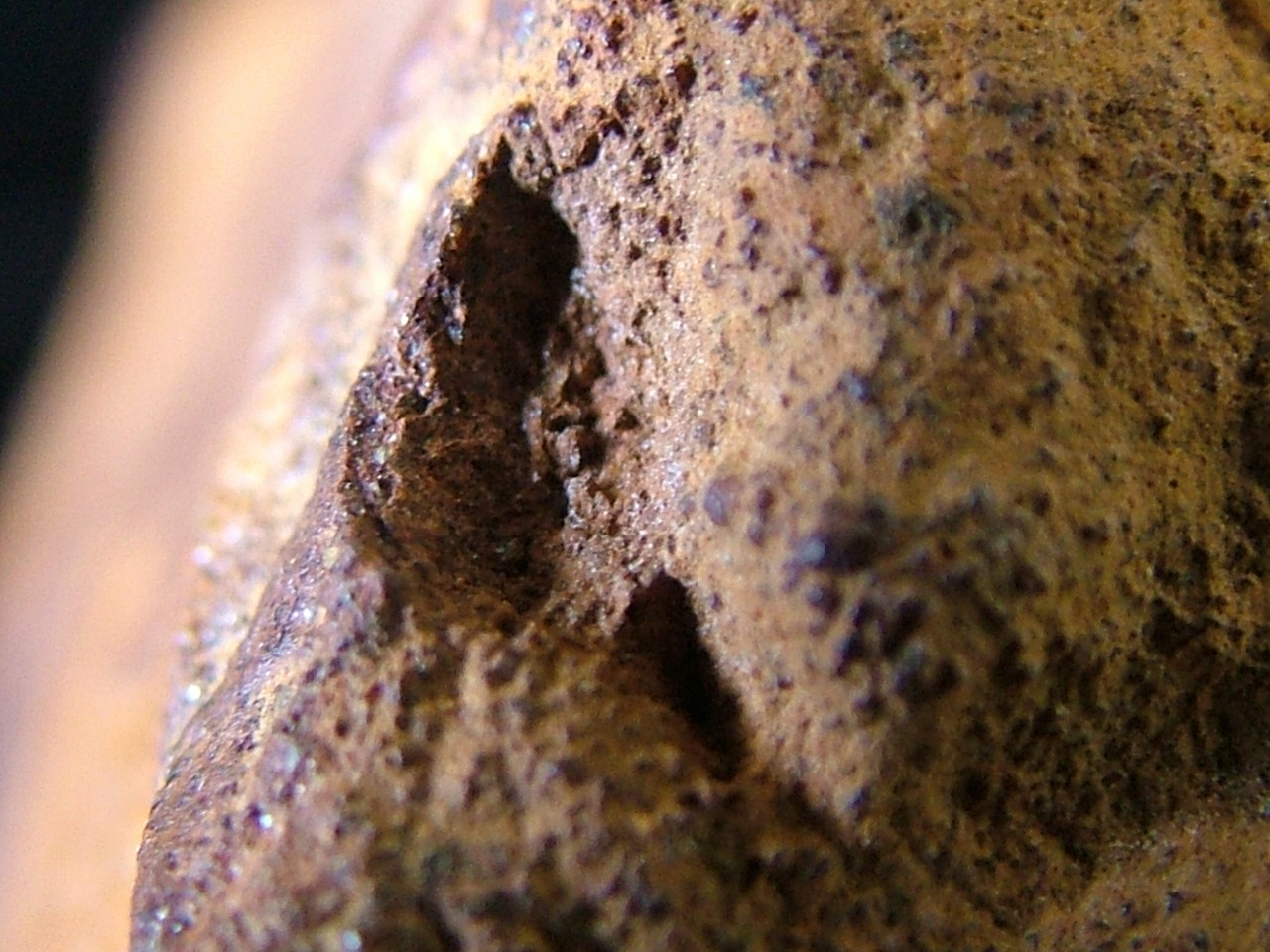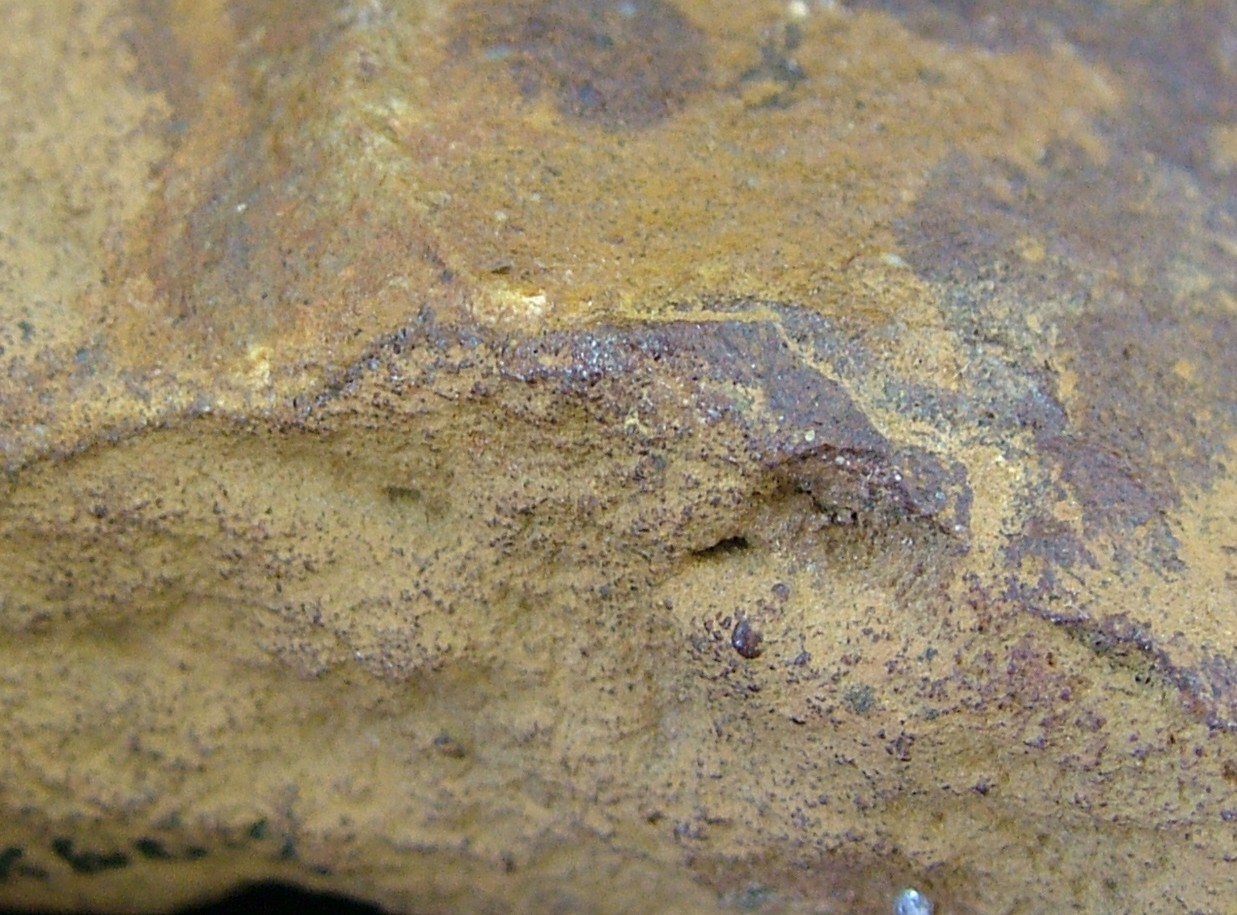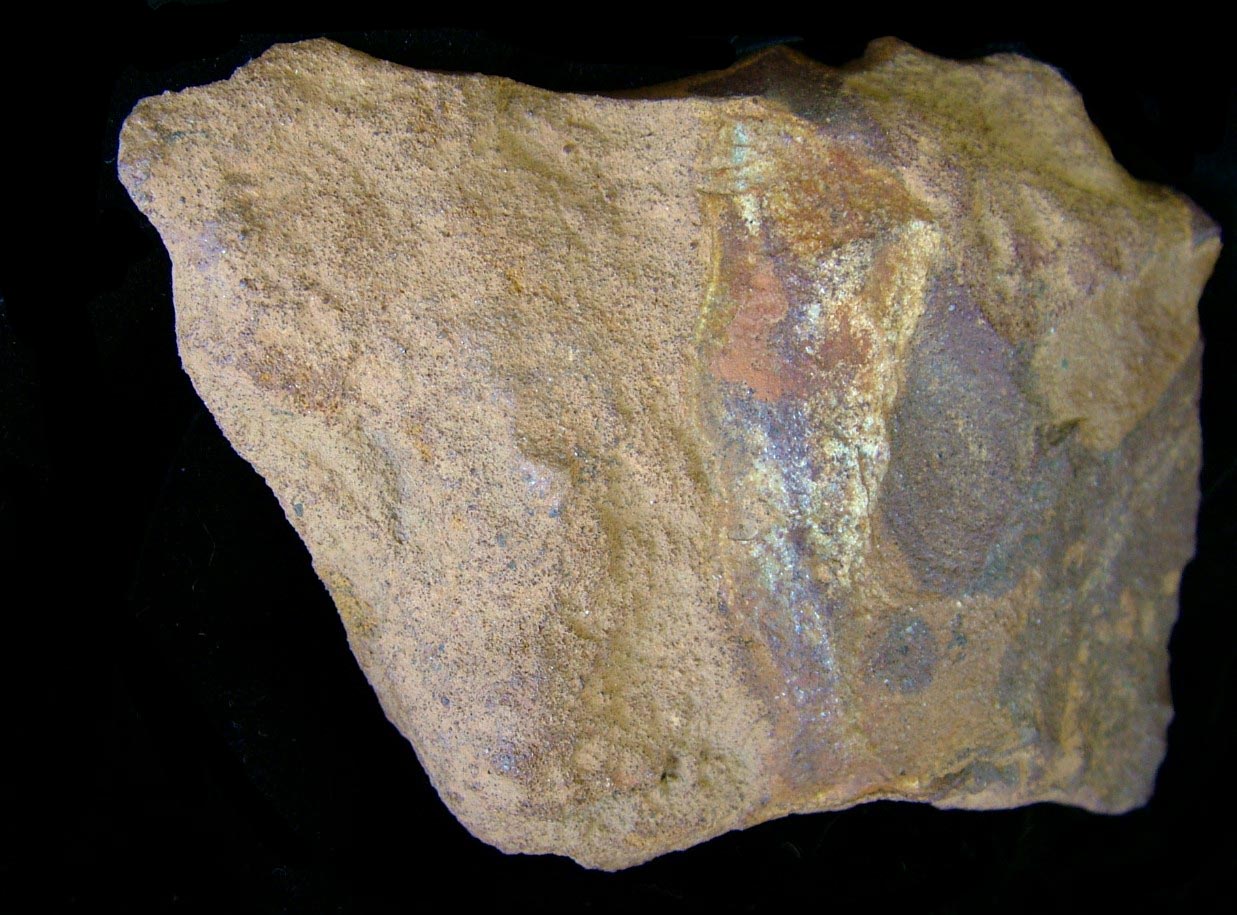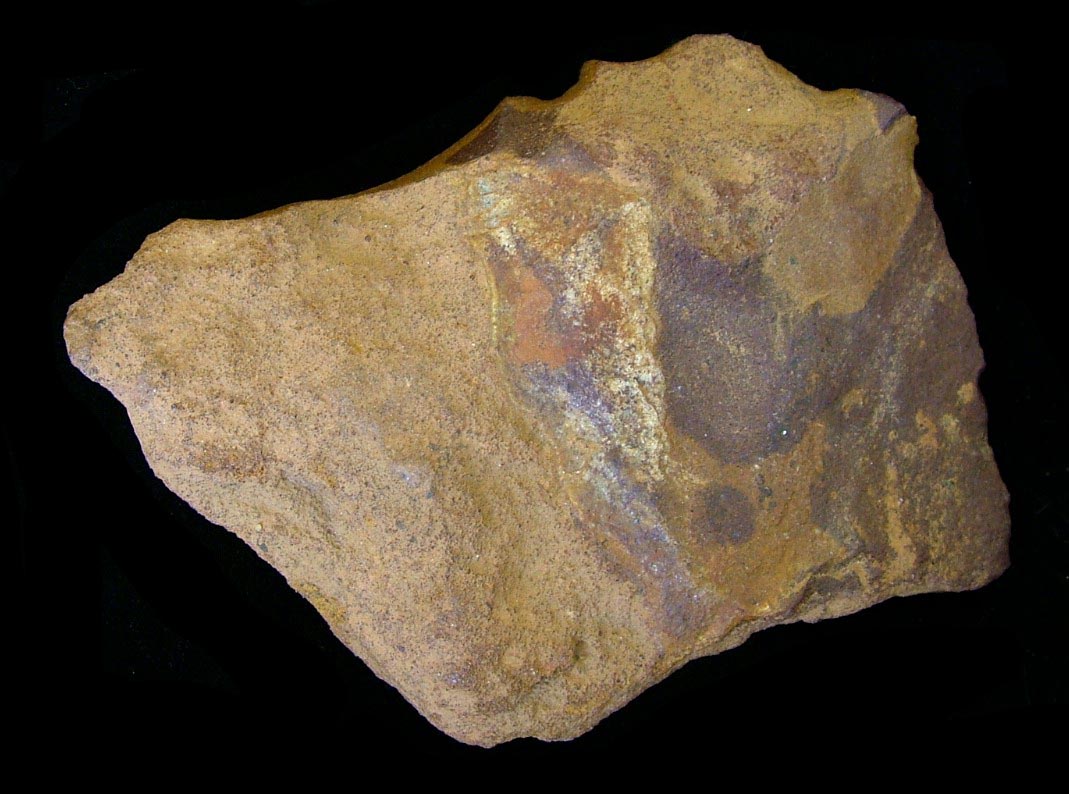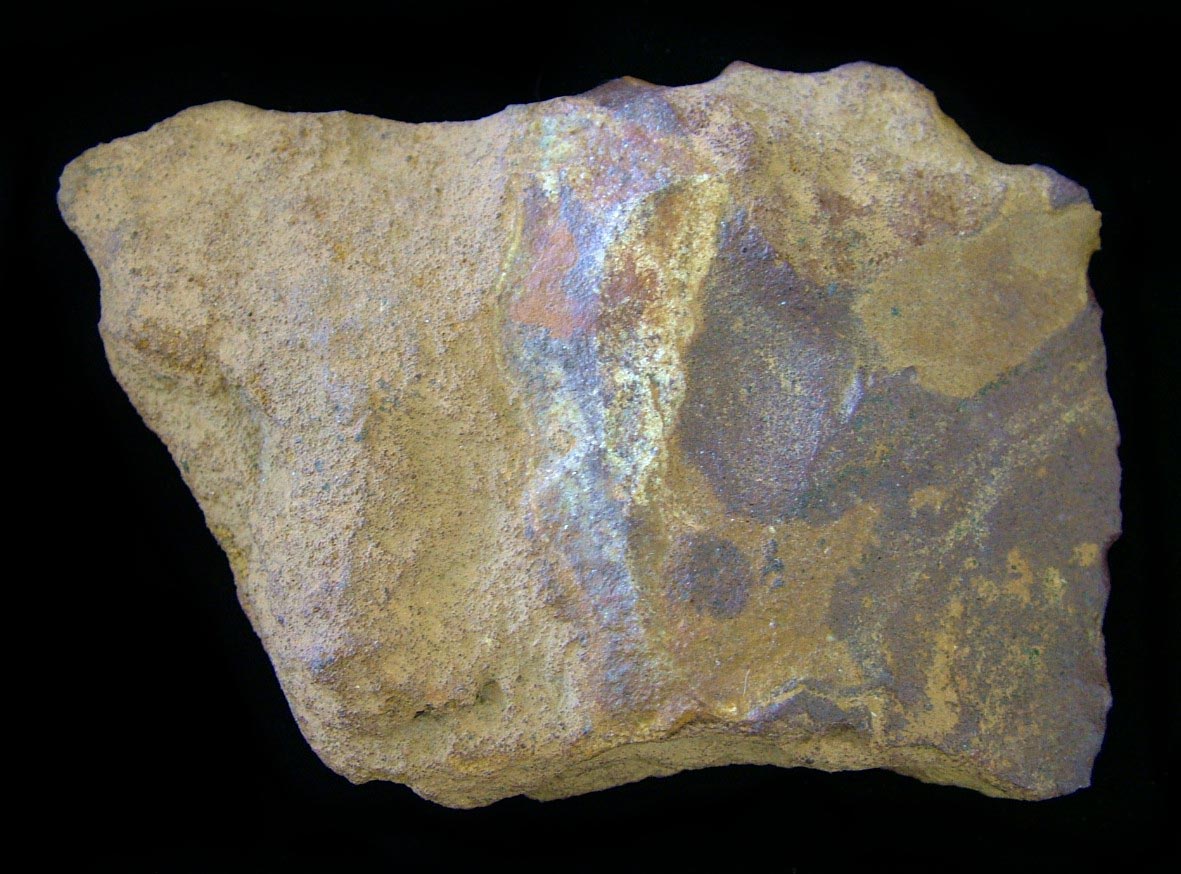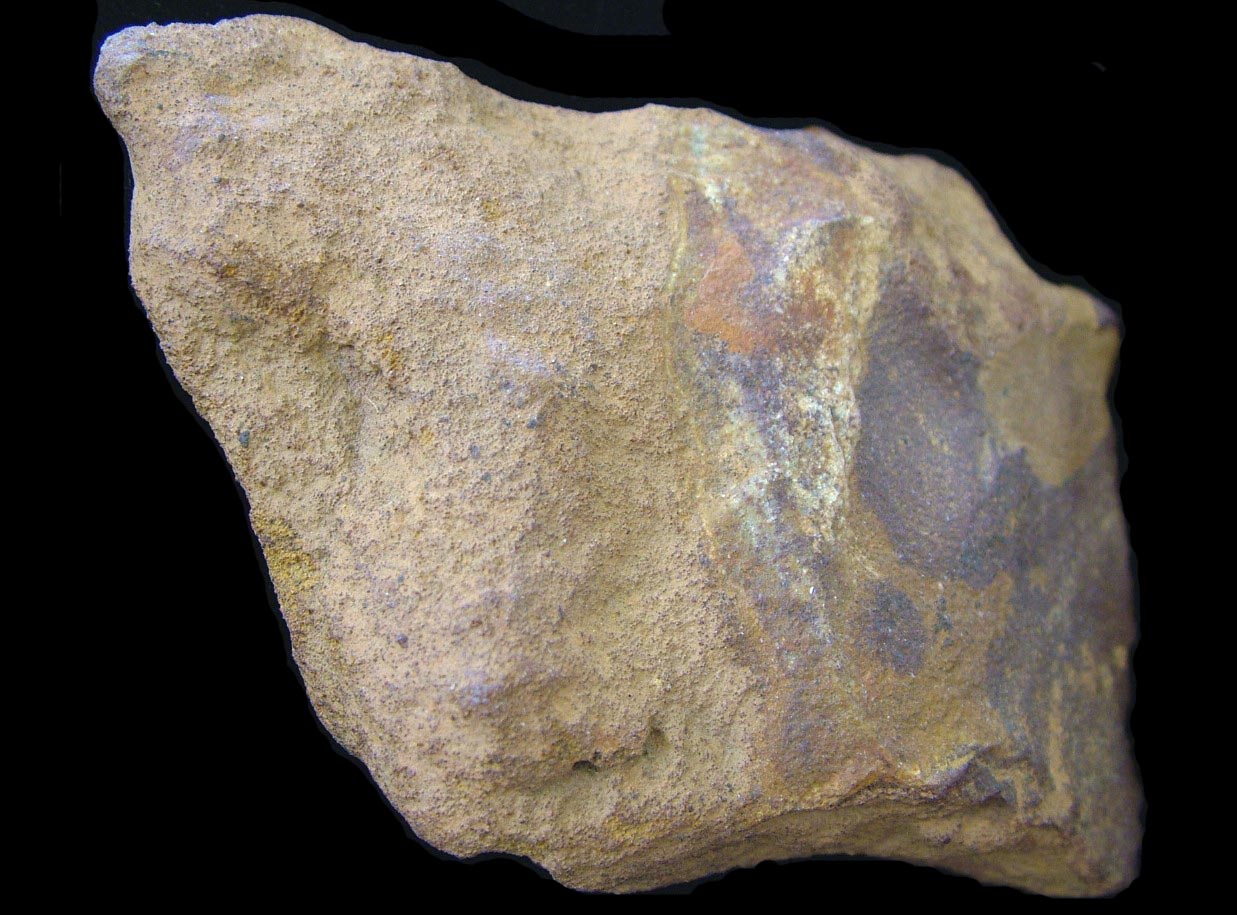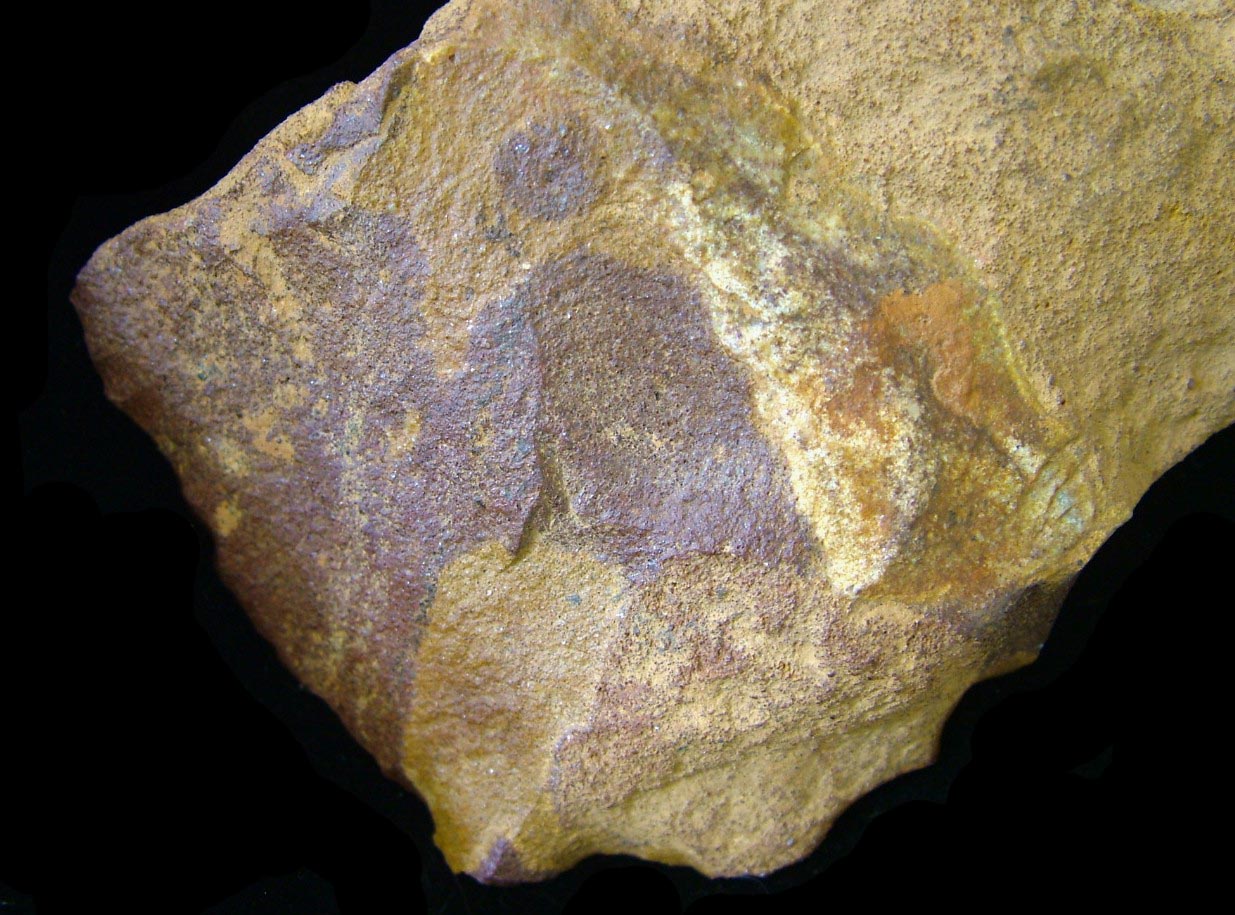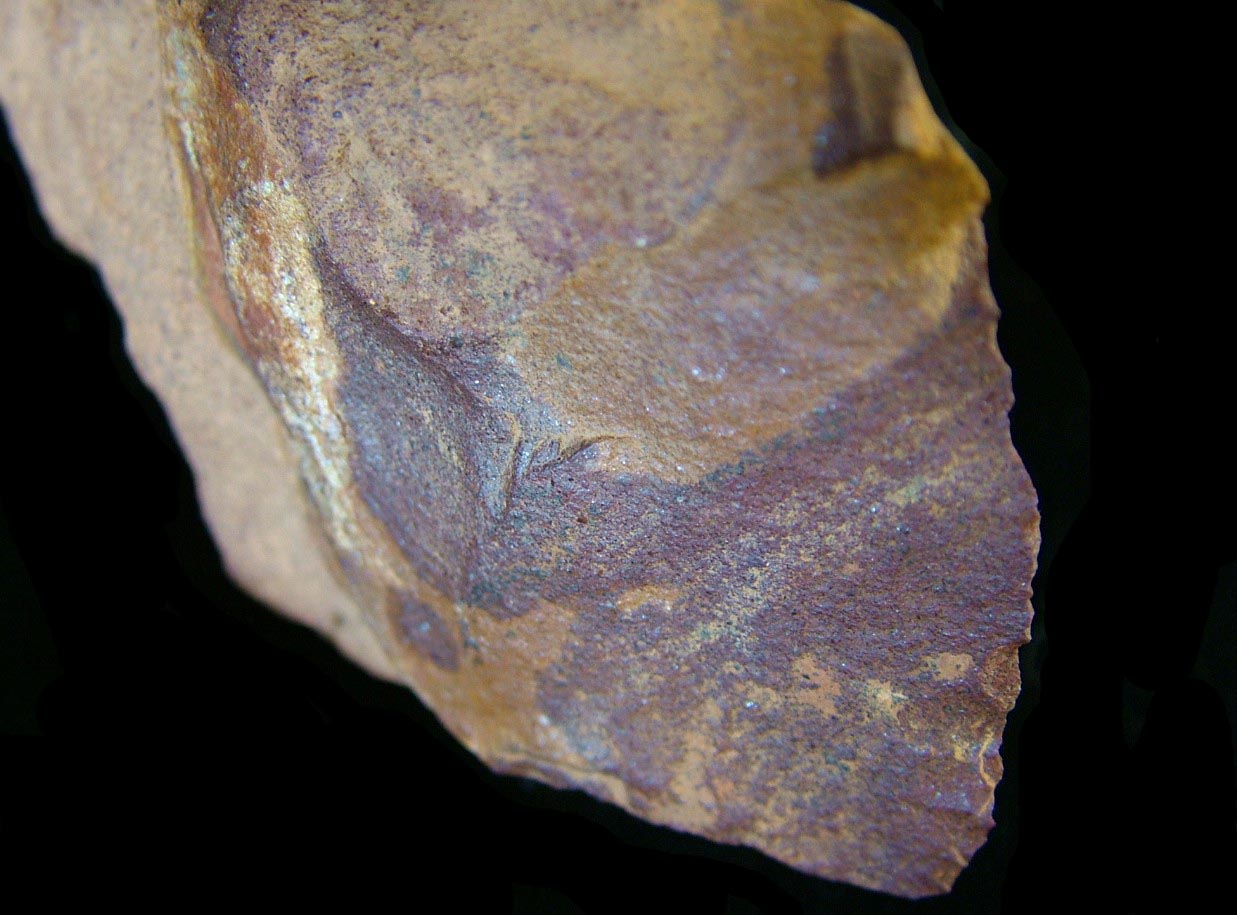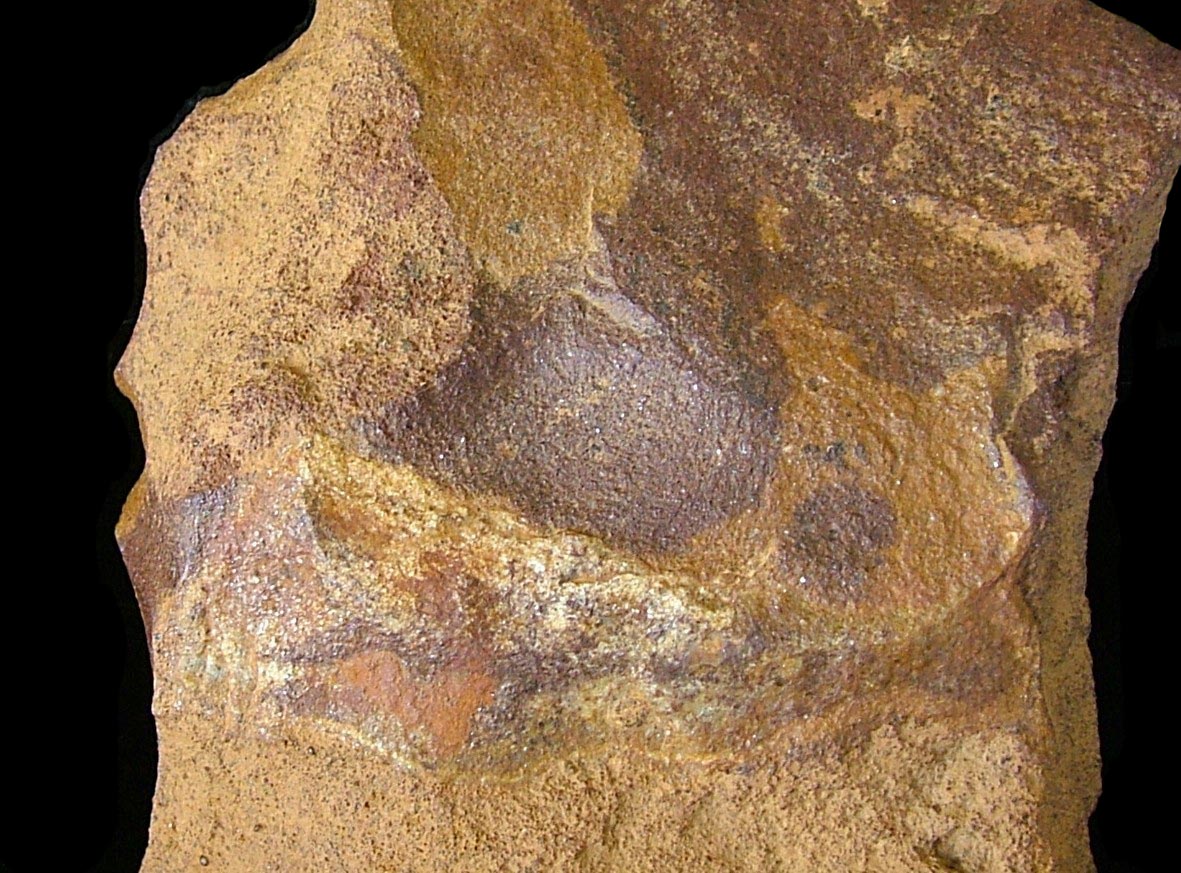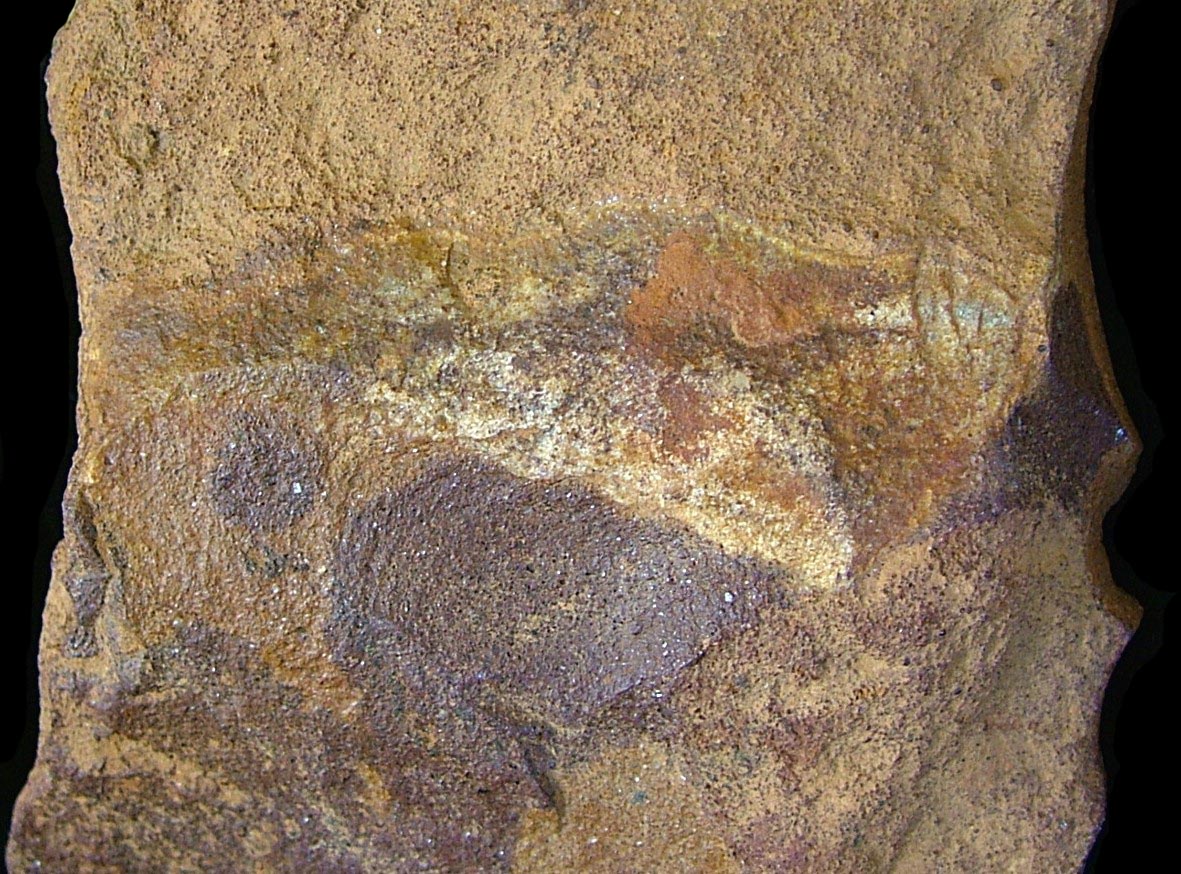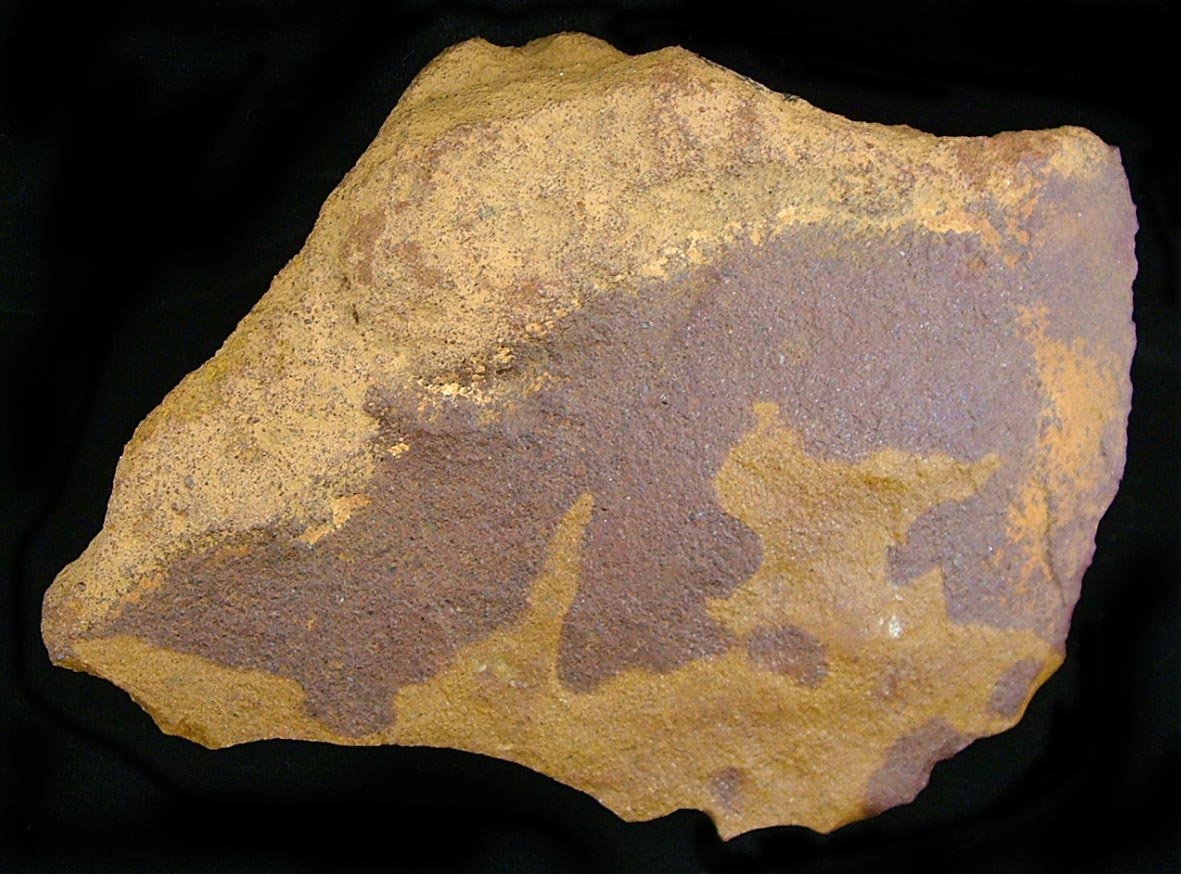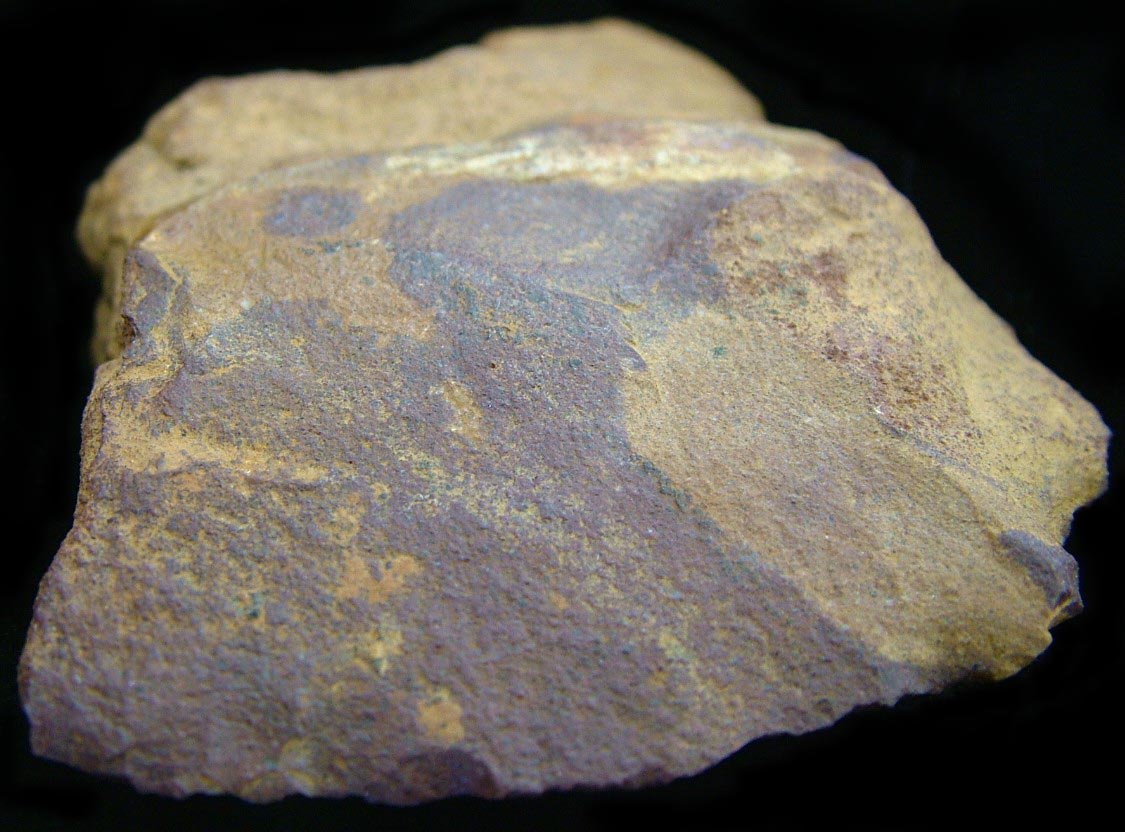 |
|---|
PALEO "BLOOD STONE" |
|
|
|
|
Although primary I consider this artifact to be one of the two most important artifacts posted on this website, the other being the "Euro Rock". The research with this is dedicated to the memory of Dick (USA, VN 67/68) and his wife Patty - True North Country Noblesse!PICTURE GROUP 1 This Lower Paleo artifact has been studied and researched for the last three years due to its amazing utility, its almost unheard of Class II condition, and above all else it's fabulous but highly complex animated art, some of which is done in micro miniature (I am still trying to figure out how this was accomplished). Based on the information about prehistoric mankind that this artifact contains, it is without a doubt the most important Stone Age object known and one of the world's most important works of art. Although I feel that the pictures provided here verify this opinion, it is still much more impressive when seen in person. I also feel that although I have pioneered this Ancient and Stone Age miniature art branch of study and done my best attempting to interpret the symbolism, there should be other interpretations. I say this as I have experienced first hand in many fields that no matter what an individual's qualifications are, or how first they are, no one is "the" expert in any field or branch. It can be speculated that if anyone gets the symbolism on this artifact even 50% correct, then they may have more definitive answers as to what is hardwired in the way of images and symbolism in we moderns, as it would appear that many of these are still with us today. Some of the main themes seem to be solar and lunar, the summer and winter solstices, and possibly the equinoxes. The lunar theme may also be associated with either the planet Venus and/or the Pole star, or both of these. There are many nature gods and goddesses, others are of the elements and the celestial, but a primary goddess (who may also be an androgen) appears to be in a supportive role to an unseen primary god; yet the primary utility of this tool appears to have to do with the feminine. I believe this tool was used in an initiation associated with the advent of a girl's menarche. It was used for cutting the hair on the head and putting it up in a specific hairstyle, and to shave the body and manicure fingernails and toenails. A secondary use was for a boy's initiation involving circumcision (that may have also included shaving the body and manicuring fingernails and toenails); this appears to have been symbolically sympathetic. Overall the tool was used in preparing for an initiation into adulthood and sexual maturity, in essence a second birth. The key with this is the red painted area that may contain a speck or specks of blood. In addition to any superstitions with transference, the purpose of the highly complex symbolism on the tool may have also been to remind the initiator of the tribe's or group's beliefs, those beliefs appear to have been their primary beliefs. If so then some of these may have been spoken during the preparation period. It appears that the initiator may have been a priestess or shamaness. There are a few heart symbols, one of these obviously represents pro-creation and apparently the nuclear family. There is much more listed with the other picture groups and it may take an hour or more to grasp the entirety of the meaning of and on this artifact; but if you have an interest in who we were, how we got here, who we are, and perhaps where we should go - Then in my opinion, it is well worth it. First I would like to mention that some of the technique used to decorate this artifact involved coating the quartzite with clay then inserting a few small specks of quartz or other stone specks, then baking in a kiln, then engraving, then painting, then further engraving, then applying a resin coating, then applying isinglass (fish glue) on at least the painted areas. There is one small key area that the isinglass was applied in many layers to give a brilliant white reflection; at a certain angle when the light hits this area it gives a brilliant flash. Some of the technique used on this tool is close to that used to decorate the "Warring States Ritual Sanxingdui Sword" (and to a lesser degree the "Arthur Lance") posted on the home page; note that there is also a cutting and a blood ritual with the Sanxingdui Sword. What is absolutely astounding with this connection is that mythical swords are in fact depicted on this 600,000 year old ritual tool artifact. The techniques just mentioned along with what may have been a great deal of care in protecting this artifact appears to be why that art has survived intact. It is in effect a time capsule and a first look at what Battenberg and its inhabitants may have been like over a half million years ago. This is a Homo Erectus Heidelbergensis (Heidelberg Man, thought by some to be the Archaic Homo Sapiens*) Quartzite Grooming Tool from the Lower Paleolithic Period, but there is more as there is every indication that this had been made by a Sapiens (Modern man), it is 9.8 cm in length. It is from a well known old German collection and originates from a famed site in Battenberg (Palatinate / Germany), the dealer /collector that I purchased this artifact from is a first rate expert in Northern European Stone Age artifacts. The site is scientifically dated at 600,000 years old. Other Heidelbergensis artifacts from the collection are in a museum collection in Germany, also I have compared this tool to tools from other locations of the same period and although I am not expert in Stone Age tools, in style there is very little if no difference. The site's code/number is painted on one end of the stone, it is K66 - 2. Some of the iconography on this artifact and the Paleo "Euro Stone" has been found to be similar. It appears that both artifacts are from the same Paleolithic "people", that is even though they may been many generations apart. There is every indicator that the Heidelbergensis that made this tool was a full fledged Homo Sapiens (modern human). Besides the advanced techniques used in making this tool, there are many depictions of faces that appear entirely modern, to many to deny that it had been made by a Sapiens. The tool's iconography shows that the artisan had an extremely advanced belief system, superior technology, excellent dexterity, knowledge of the celestial, and immense artistic creativity; that is even for a mere 6,000 years ago, let alone 600,000 years ago. It also appears that this Sapiens was probably of a tribal culture vs a band or family group. As I have another example (the Paleo "Euro Stone") to provide further evidence, then I have decided to give those advanced but unknown "people" of the Lower Paleolithic a name and identity as the "Vor Culture". The word vor is a German root word that means a head of or in front of, thus implying that the Vor were advanced, progressive, etc. This is the first time that a claim of a people of such great antiquity has ever been made with artifact verification, the proof of course is with the iconography and the technique used on the two artifacts. The information with the following pictures are of areas on the top and one side that have micro amounts of organic material, this includes a micro sliver of grain (that has been worked to appear as a ritual baton), a small piece of amber, and paint (from minerals) mixed and coated with resins, and Isinglass (sturgeon glue) or something similar. The artifact has carvings, engravings, and has been baked in clay. The paint used with this are; black, brown, purple, blue, red, orange, sienna, yellow, and white. Some of these paints amazingly were mixed and some of the paint has a semi-luminous effect, this is particularly seen with some areas with small amounts of white paint. It is not known how the Vor created miniature art that in some instances is less than a millimeter in length, but it exists and it is excellent for any period in history. A main theme with the art has to do with torches, but particularly with a torch / fish woman. Among other things and besides the sun, the moon, the dawn, possibly Venus (as the evening and morning stars), and possibly the Pole Star it appears that "they" worshipped; a great bear, a great straight tusk elephant, a great horse, a great hare, a great bear dragon creature, a bird, several types of fish, sturgeon roe (caviar), a crocodile (possibly another type of dragon), blood (among other things as a type of dragon), the kiln, a stone sword, a straight elephant tusk sword, a fish bone or fish bone / bird bone sword, the summer and winter solstices, possibly the equinoxes, possibly the constellation Bootes (aka Arcturus), possibly the Milky Way, meteors/meteorites, comets, the blue sky, ball lightning, volcanoes, trees, grain, amber, tin, bits of iron, and rock crystal. The finger grips on the stone show that it was made as a precision tool that has a spring action. This spring action will come from placing the index finger along the top while holding it in the right hand, when the index finger is pushed downward this will push the lower point against the upper palm (with the fleshy area just under the thumb) and create a spring tension with the main blade cutting backward, then when the index finger is released up, the stone's main blade will spring with a forward cutting motion. With ease it can give approx. one back and forth cutting motion per second - This has been tested and works perfectly. There is no doubt that this tool was made for cutting hair, but it was also made for trimming and filing finger and toe nails, and for shaving the face and body. Along the stone's bottom front there is a sharp wavy area with three different points, this is the area that was used for trimming and filing finger and toe nails. Along the stone's bottom back there is a slightly curved area that is 3.9 cm in length, it is as sharp as a knife and it can be expected that 600,000 years ago that it had been razor sharp. The finger grips give an exact hold (for a hand equivalent to an American 9 to 10 glove size) for shaving the face, or arms, or legs, or any or all of these areas. The iconography highly suggests that this grooming tool had been made as part of an initiation for both sexes. *Archaic Homo Sapiens are thought by most paleontologists to have developed in Africa 200,000 to 180,000 years ago, with Homo Sapiens development beginning 50,000 years ago. |
|
PICTURE GROUP 2This picture group and the next three shows the tool in the same upright primary position when used for cutting. Overall there is a female figure painted in bright colors next to a large sienna colored bird's head. The focus of this particular group of pictures is with the top of the bird's head. To the left there are two figures (one brown and the other pale yellow) as if leaning back on and along a large horse. The horse has a small white/yellow area near it's ear. Under this and in the horse's eye there is a small translucent capped mushroom. This has to do with a solar theme, it should in fact be a theme of a sun runner. |
|
PICTURE GROUP 3This picture group shows what appears to be a goddess holding a dark brown orb that has a small figure holding a light colored ball (possibly a pearl), when moved in various positions there are many transforming figures seen in this, I would say it very much has quite it's own story. After much study this figure is overall of a birch tree, this is important as when this same area is seen upside down it is of a torch, but also on the other side there is a primary theme of the chaga mushroom (chaga is aka true tinder and is used in making a highly touted medicinal tea) that is almost always associated with the birch. There is a white sitting figure with a crown that may be a female, but there are a few suggestions that it is in fact an androgen. In the detail pictures the sitting figure has one golden eye and the other eye is if being taken out or replaced. The sitting figure may be a celestial deity that is either being created or transformed. The lower half seen on the left is a large bovine head (that is part of the white androgen) facing to the left, to the right on the bovine head there is a woman in red hair with a distinct hair style (she is best seen in Pictures 11, 12 and 17), this is an important theme*. In front of the red headed woman is a darker red figure in a hood, it is the top part of a red portion of a white and red cone (although in certain positions both the cone has several faces on it). Under the cone is a type of light blue bowl being pushed by a dark yellow and brown figure (but also figures) that may be a blue sky symbol, the bowl and the cone also appears as an upside down mushroom. In front of the red hooded and white cone figure is a flesh colored disc with a face on it (but in other positions this can also resemble a wing), this may be symbolic of a renewal. The white and red cone appears to be a tampon, if so then it suggests that at least some of this has something to do with a woman's menstruation, possibly seen as a sacred life giving blood rite. With the former speculation there is the online "Issue 11: Summer of the Goddess Pages" by the free-lance writer Andre Zsigmond. In the article Zsigmond writes of ancient myths connected to menstruation as a life giving force in his essay titled "Mythology, Menstruation and the Land of Milk and Honey". The fact that there may have once been a blue mushroom associated with menstruation is worth noting for blue mushrooms do in fact exist, there is the Entoloma hochstetteri (considered inedible by the experts, but yet confusingly it is unknown if it is poisonous or not) of India and New Zealand, then there is also the edible Lactarius indigo of North America; but yet there are no known myths or folklore traditions connecting hose two mushroom types with menstruation or anything else that I know of. So my speculation is that if there had been a Paleo blue mushroom in what is now the Palatinate, then it may have been a completely different species, or that perhaps that there is something about our contemporary blue mushrooms that we simply don't know yet. My theory is that the blue cup/blue mushroom motif suggests that the Paleo blue mushroom may have been associated with a drink concoction that provided relief for Premenstrual syndrome (PMS), this may have been based on fact rather then as a convenient symbol for the blue sky. Pictures 18 thru 20 show a scene to the lower left, although this is a water/flood/boat scene in another position, in this position it shows a large totem with a cat's head (that may be a prehistoric homotherium, a scimitar cat) being placed horizontally on a tree stump, there are various figures around this. * The women in the red hair has her hair up with a ponytail on top of her head. Although not seen in these pictures when the tool is slightly moved it will show a ponytail in a top loop, also when in this position it shows a smaller rounder woman (no doubt a girl) with long dark hair in the background. My speculation with this hair color and hair style symbolism, the Vor, and three categories of females is as follows: First, when a Vor girl reached maturity (her first menstrual cycle) and if her hair was of a color other then red, then it was dyed red (from henna or something similar) and then ceremonially styled in a pony tail on top, and then kept in this style. If this is correct then it would have been symbolic that not only was the Vor woman sexually mature, but also available. Secondly, that when a Vor woman had been chosen or chose a mate that her ponytail was then ceremonially styled in a top loop, although this may have been symbolic of either having had a child or a pregnancy. If this is correct then it would have signified to others that the Vor woman was with a mate and therefore unavailable. Thirdly, that a Vor girl wore her hair long and if not naturally dark, then it was dyed dark (from indigo or something similar). If this is correct then it would have signified to others the Vor was a girl and therefore unavailable. If these categories are interpreted correctly then appears that the Vor may have had a strict set of mating guidelines. More photographs of this area and theme of the tool will be added in the future. |
|
PICTURE GROUP 4This group of pictures is of the front of the tool, this is where when used for cutting it touches the inside of the palm between the index figure and the thumb. It is the area that has the backed clay exposed, there are minute amounts of brown or black paint and larger amounts of bright yellow paint. Various pictures show a large tusk elephant with an extremely large oval eye, a large hare, a large cervidae, a large vertical straight sword pointing downward, a kiln with a chimney, a hominid's (great ape's) head or a primitive head of a homo genus, and a large heart with figures in it. There are indicators that the straight sword is an engraved stone sword covered in baked clay. There is an important theme of a vertical sword/chimney and a hominid or primitive man (that is also a kiln and a mound) of trepanning (the cutting of a hole in the top of the skull), I do not think that it is a medical procedure and it appears very much like a "sword in the stone", this may or may not be coincidental, It may represent the releasing of bad spirits and, or attaining consciousness. If it is a depiction of a primitive man's head and although there is no supporting evidence, it could be speculated that either the true Heidelbergensis or Neanderthalensis had been a result of interbreeding between this recently discovered type of Sapiens of 600,000 BC. Either way if this is a theme of attaining consciousness, then it may represent the ultimate gift (or one of two ultimate gifts) from the primary god for those entering adolescence, although it is very probable that adolescence over a half a million years ago was the same as modern adulthood. Picture's 16 and 17 shows what appears to be small horse near the sword's hilt. The large sword may or may not be connected to the horse, but due to the size of the sword and with no large figure connected to it, then it appears the sword is of a enormous unseen force, if so then in my opinion it is the sword of a primary celestial god that is connected to the sun, but yet more powerful. |
|
PICTURE GROUP 5This group of pictures shows the same area of the tool but during other times of the day (different daylight), there is more definition. Pictures 1 thru 5 shows the same theme, except at a more frontal angle, the area around the sword has transformed from the large oval eye to a large circle. Pictures 6 thru 10 focuses on the heart area. There is a man's head with a mustache and possibly a short beard, just under this is a micro sliver from what appears to have originated from a grain (it is 2 mm in length) that is engraved, it may have been from a cereal grain, it is coated with a resin, and like everything else on the artifact it is fossilized. The grain sliver is shaped like a baton with a circle on top (there are larger more defined pictures of this at different angles with other picture groups), this should be a primary solar theme. Pictures 11 and 12 shows this area in brighter daylight. The man's head with a mustache inside the heart is more pronounced, under and next to this is a dart with a circular ball under it, this hints at a male fertility symbol. but yet with the heart it may in fact be a male and female fertility symbol (procreation). Pictures 13 thru 23 shows this area of the tool under even different daylight conditions. Various picture's show a child's face near the top and to the front of the straight tusk elephant's head, the child's face has one pointed ear that pointed is up (to the left) and one that is pointed down, this hints at a connection to a mouflon (wild sheep), it may be a solar god, perhaps even the son of the proposed primary unseen god connected to the straight sword, there is also another face to the right of the child's face. The mouflon with the heart may also be a symbol for compassion, if so then it may be a second ultimate gift from the primary god, or a gift from the primary goddess. The hominid or primitive man's head has transformed into the head of a homotherium. There is a figure that is holding a scimitar sword pointed diagonally downward on or though the homotherium's head. To the right of this is an indented area that is also the straight tusk elephant's tusk, note that it is the area where the grain sliver is. The tip of the scimitar sword is on the mouth of the homotherium. This theme suggests that the tip of the scimitar sword of the straight tusk elephant is being used to make a fang for the homotherium's head, the homotherium's fang may be a solar symbol. This suggests that the homotherium and, or it's fang may have been a symbol of the rebirth or birth of the sun. |
|
PICTURE GROUP 6Pictures 1 and 2 shows the area where the stone tool when being used is between the thumb and index finger. Pictures 3 and 4 shows the grain sliver as representing a type of baton with a circle disc on one end and a bird's head on the other. As previously mentioned the grain sliver is positioned on the tool between the index finger and the thumb, this may represent the holding of an actual baton, or holding of the holding of a handful of grain, or both of these. Pictures 5 and 6 shows an area on the tool that represents the bird head's cave or an enclosure, although faint in these pictures there is a cat type head facing on the left of the cave and facing to the right (although much clearer almost this same theme is seen on one area of the "Euro Rock", in front of the enclosure is a bead (most likely from a seed or a nut) coated in resin (this is also another theme seen on the "Euro Rock"). To the left can be seen the previously mentioned piece of inserted carved quartz crystal, it is independent and not part of the quartzite stone tool itself. Pictures 8, 10, 12, and 14 show the detail of the carving on the quartz crystal, near this is a small bit of lead or tin, or lead/tin alloy, although not seen in these pictures it is engraved. Pictures 15 and 16 shows the cave area in a different position, note that it has a vertical burning torch with a cutout for a flame. |
|
PICTURE GROUP 7Pictures 1 thru 3 show a large bird's head (possibly an eagle or raven's head) as a hill or on a hill, the beak is a cave. The cutout is a burning torch pointed diagonally down with a figure holding it, with this Pictures 2 thru 3 show that the bird has a human arm and hand. This should a Prometheus type story of a bird or bird-man god delivering fire to man (this is also known with the myths of certain North Eastern Asian and North West American native tribes), but there may be even more with this Paleo bird-fire story. If you would like, go to the "Sarmatian War Chieftain's Aquila Pendant Trophy of Legion XXI Rapax" with the "Roman Officer Permanent Collection Roman Military Artifacts" and I think you will see a few similarities with the images here and the Sarmatian legionary eagle cave sacrifice (that is in the beak opening). For years I have taken a position that the fire worshipping Sarmatians as well as some tribes and metal smiths of the Thraco-Dacians had at least a few Neolithic (or even Paleolithic) European traditions, now I am convinced of this. Picture 4 shows a close up of an area of the bird's head, there is a small amount of flattened bone or bone paste in the center that is carved, it is a fish-woman (mermaid). Pictures 5 thru 7 shows the cave, but more as a figure or figures holding the cutout burning torch in an upright diagonal position . Pictures 8 and 10 shows the flame of the burning torch is now a single horn on the head of an animal of the Cervidae family (although it may just be a fantastic animal, or a memory of an extinct animal) that is streaking to the left. The pictures also shows a small amount of tin or lead/tin and a small round quartz crystal insert. In Picture 8 shows the quartz crystal shows with a a small pin, the top of the pin appears to be made of a speck of iron (although this is not verified). As the quartz crystal appears to represent the moon and, or Venus; but may also represent the Pole Star then it may be in line with a much later tradition of the jeweled headed Pole Star beliefs of the ancient Vikings or the Pole Star spike beliefs of certain ancient Central Asian and Mongolian tribes. |
|
PICTURE GROUP 8Pictures 1 thru 3 show the cave as an enclosure. There is a cutout of a very large torch pointed diagonally upward to the left. There are various figures in the enclosure. To the left there is a small blue/tan/white mask made from bone paste. Pictures 4 shows the cave scene and the quartz crystal, the burning torch is pointed diagonally downward. Pictures 5 thru 7 show a large tooth pointed upward with figures and the diagonally downward burning torch. To the left of the tooth and below it, there is a large bear head in a pointed cap that could also be a flame. I have seen the bear head in pointed cap (or just the bear head) that is associated with fire with ancient artifacts from seasonal cold weather cultures from Europe to the Far East, it is connected to metal smiths. In Europe this motif was popular with the Thraco-Dacians, the Sarmatians, and later with the Vikings. |
|
PICTURE GROUP 9This group of pictures is in an upside down position (when used as a hair cutting tool) it shows a bright colored fish/bird goddess coming from (or is part of) a torch, there is also a white oyster shell goddess that can transform into an androgen. Pictures 1 thru 3 shows that the area where the torch goddess is on the flat of the tool, is over where the bird with the beak of the cave/enclosure is. Picture 4 shows a torch holder with a ball pommel over a fish tail, next to it to the right is a large dark ball, in other pictures groups this will change as the torch is initially a club that hits a massive bear head in the left eye popping the dark ball (eye ball) out, the inside of the club has a torch and a knife. Picture 5 shows connected to the torch holder is a large white face spitting on the large dark ball. Various Pictures show that the flame on the torch is a red woman in a black pointed hat, her bottom half is that of a fish, she is holding a triangular head with red hair that in some positions may also be a heart, next to her is a woman in a black pointed hat. The red fish woman has or is connected to a large white face, in some positions the oyster shell holds a white stick. Over the red fish woman is the head of a light blue woman that at a distance and in one position may appear as a nipple. From the shell and projecting towards the light blue woman's face are flames coming from the oyster shell. In some positions that flames show figures, but also a main bearded figure that is as if embracing or attacking the light blue woman's face or other figures in the light blue woman's face. In other positions the flame appears as a bearded man with a curved tusk, it hints of a Wooly Rhino or a Mammoth. In Pictures 16 thru 18 the combination of the light blue woman's face and the flames appear as a type of Bison-man's face. Picture 13 show a type of bone dagger or, short sword, or pick tool with a bird's head pommel, as this can only be seen in this one very exact position, then it should be expected that it was viewed as a mystery or secret weapon or tool. If a ritual sword of this type did exist, then most likely it was made from fish bone, or fish and bird bones. The fish woman may be a fertility goddess similar to the Roman goddess Venus or even Venus Victrix (Venus Victorious), my research shows that among other things Venus Victrix was a goddess of blade weapons (but particularly swords and daggers) and in the tradition of an extremely ancient goddess. |
|
PICTURE GROUP 10This group of pictures shows the tool in various positions and with additional detail. Of note is the following: Picture 1 showing a massive long snouted bear's head with an overhead cervidae streaking to the left. Picture 2 shows figures in what may be a round boat (with only half the boat showing) or a sled. Pictures 3 thru 7 show the front area. Picture 8 shows a horse's head with a streaking mane and a large eye. Pictures 9 thru 12 shows the goddess and detail. Pictures 13 and 14 show a large hare's head. Pictures 14 thru 17 show the area with the bird headed sword. Picture 18 shows what may be a triangular dagger in between the red female in the pointed hat and the female in the black pointed hat, it is if it is a splitting. Picture 19 shows that the red female may be holding a hat with a face that may also be a vessel with a heart or flaming heart in it, the hat may be coming off from her head, if so then it may suggest that her head had originally been combined with that of the female in the dark pointed hat, if so then it hints at a splitting. Pictures 20 and 21 show a round faced figure holding a stick with a flower and floral figures next to it. Pictures 22 thru 26 shows the fish tail with figures and a scene, there is a figure to the left. Under and on the bottom of the tail is a golden snake or serpent. |
|
PICTURE GROUP 11This group of pictures with picture 1 shows the bear's head at an angle and details of the fish woman with pictures 2 thru 5. With this picture 3 and 4 shows the oyster is a white figure in a pointed hat holding a figure or figures, the white figure is also a long stick with a flame. Picture 5 shows a crocodile biting something. Pictures 6 thru 10 shows this area upright but with more daylight. |
|
PICTURE GROUP 12This group of pictures shows the long snouted bear's head in connection to the torch. On the long snouted bear's head there is a large round headed figure with many other smaller figures as if on a handle or a thick stick, there is every indication that this is also a tree, possibly an oak tree. With pictures 4 thru 6 there is a hint of breasts on the thick stick, the breasts also hint of the eyes of an owl. The oyster shell on the torch now appears more as of being separated from the torch due to a force of impact. |
|
PICTURE GROUP 13Picture 1 thru 4 shows the long snouted bear's head with a streaking overhead cervidae, it's right eye is as if squinting, the dark ball to the lower right of the torch is seen as if shooting diagonally from that left eye, the long snouted bear has a horn in it's mouth. The horn may have originated from the cervidae seen on top of the long snouted bear, it may in fact be a mouflon (wild sheep), if so then the taking of a mouflon's horn may symbolize the winter solstice There is little doubt that among other things that not only is the shooting dark ball the bear's left eye, but it is also a meteorite..There is a hint that the painted torch and flaming knife on the center may be cauterizing the left eye. This bear-meteorite theme is not only similar to the theme of the same on the two artifact both listed as "Torc Bear Meteor Pendant of The Thraco Dacian Goddess Bendis" on kingarthurbanner.com, but to a lesser degree it is also similar to the meteorite theme on the "Saxon Ring Of Arthur As The Scythian Navigator, Thunderer, and War god" that is also posted on that website. It also hints at the sacrifice of an eye for wisdom myth of the Norse god Odin. Pictures 4 and 5 show what may be a bearded figure on the bear's nose. Picture's 7 thru 10 show the grain sliver, it is in the area of the squinting right eye. Picture's 11 thru 14 show various figures on the long snouted bear's head and to the right near the torch. Picture's 15 thru 17 show what appears to be an ape or ape like creature's face with wide flat nostrils. Pictures 18 thru 32 shows the inside the right nostril in the positions of the four cardinal points. Inside this area at just the right angle there is a micro speck of white paint with a scene on it in the first position, and symbols in other positions, in the first position it appears to represent the white hide of an animal, no doubt this theme is of a mystery rite. |
|
PICTURE GROUP 14This group of pictures focuses on the front of the blade of the tool. Pictures 1 thru 4 shows a thin bearded figure with some type of container as if pouring, behind this is a larger bearded figure. Pictures 6 and 7 shows a large combination creature of wolf or cave hyena dragon with an open bird's beak, there is a bearded figure in the beak and a hint of flames. Picture 8 shows that inside the creature's face is a man's face, under this is a long creature that is also a canoe or boat. In front of this is a large bird's head. Picture's 9 thru 13 shows that the creature is now a bear dragon bird with an open beak that now has teeth, there is a small head of a bearded figure in the canoe. This is also begins to show a large figure on the right as if leaning over with the bear dragon part of it's head and on top, there is a scene and many figures inside this. Pictures 14 thru 19 show that same figure just mentioned is in fact a mouflon man or boy, or more specially a ram man, specifically Picture 17 shows a sitting figure to the left in a conical pointed hat. The canoe is now also a long streaking arm with a hand and a boot that is striking the phallus of the ram man, the phallus is also part of a flower (that is split) connected to a fish tail. To the left and connected to the streaking arm is a half boot that is stepping on the container mentioned previously. The top of the ram man is a long vertical creature. The ram man has a bright yellow spot in front of his forehead. Pictures 20 and 21 show that the bright yellow spot is in fact a figure wearing an evergreen tree hat, there are various other smaller figures. With the exception of Picture 24 (which is another close up of the figure in the evergreen tree hat) Pictures 23 thru 26 shows that there is a suggestion that the ram man is receiving or combating forces, or both of these. |
|
PICTURE GROUP 15This group of pictures is of the same area of the tool as the previous picture group. but in other positions. Pictures 1 thru 3 show what hints of a face or many faces and a head sling, more importantly it shows that the long arm and boot come from above. Pictures 4 and 5 show that there is a sled or boat with a horse's or cervidae's head, there is a vertical branch on it's forehead, it is as hitting or glancing the container, the container has what appears to be smoke coming from it. This may have something to do with carrying a coal of a sacred fire. Pictures 6 thru 9 show the long arm and boot, the boot has a type of animal with a snake or serpent under but also on the toe. Although it is not seen well in these pictures, the boot has a face on it. Pictures 10 thru 12 shows the container and the horse headed sled or boat. Pictures 13 thru 14 shows a scene inside the large face with a head sling, there is a nude kneeling figure, it may be of the underworld or other world. Picture 16 show's a short bearded man to the upper left and a large scene to the right of this. Pictures 17 thru 19 shows a scene with a figure slanted to the left, he is wearing the horse headed sled or boat as a headdress. The slanted figure is also holding a long branch as a staff, it has an animal or creature's head that is biting a figure in front of it, there is a hint that it may be biting a nude female. |
|
PICTURE GROUP 16This group of pictures focuses on the scene just under the scene of the ram man and the brightly painted middle of the tool in a vertical position. Pictures 1 and 2 shows a horizontal fish creature facing to the left, on the upper right on top of the tail is a large sitting boy holding a dark ball, he is sienna colored with dark brown hair, the boy's hair is also the boot with the previous group of pictures. Picture's 3 and 4 show the detail of the boy, in front of him is a white crocodile that is biting something. Pictures 5 thru 8 shows the container, it is made of circular branches with a scene in it, it is pouring out figures that make up another scene. Pictures 9 and 10 show the container in a different position, in front of it where it is pouring is a large sitting figure. Pictures 11 thru 18 show the front of the fish creature. Specifically with pictures 11 thru 17 shows a creature with a white shell with a large cat head that is biting a fish, there is a triangle that may hint of a fish trap. There are many figures inside the cat's head and fish's head, there is also an overall scene that will change when moved. Also specifically with pictures 17 and 18 the cat's head now is somewhat like a man or woman's face in profile, there is a hint of a volcano. Pictures 19 thru 36 are of the fish tail area, what is seen with this that is most important is one area that was worked to produce a bright white pop up reflection in a micro indented area. This is seen under a bright pale yellow "V" that when slightly moved shows a head with long yellow hair to the right and above it, it is shaped like a heart. When the tool is slightly moved the micro indented area will first show a bright white diamond, when moved a bit more it will show a bright white shape that is similar to a number "3" with a dot in front. Picture 32 shows a close up of this motif, it is two figures with a smaller figure in the middle. In my opinion this pop up represents the planet Venus, procreation, and the nuclear family. Although it can not be seen clearly in these pictures, pictures 33 and 33 shows that the "V"/Long yellow haired figure is also two figures. Pictures 35 and 36 shows a long wavy figure on the tip of the fish tail, there are smaller figures, the long wavy figure is facing the quartz crystal (that is blurred). |
|
PICTURE GROUP 17This group of pictures is of the same area in the middle as the previous group, except it is upside down. Pictures 1 and 2 shows a scene with a jumping fish, it may be a salmon. There is another fish facing a type of red dragon creature that among other things may be a type of water dragon, as mentioned previously the red painted area on this artifact may be of particular interest as the red paint is different from the other paint, it has a distinct flat dull texture. The reason for this may be that red ochre contains un-hydrated hematite (just as yellow ochre contains hydrated hematite) that contains iron, but due to a few bits of organic material on this tool then I suspect that the red paint may also have had minute amounts of blood added to the paint, that is even though dried blood is dark rust-brown to black in color. To explain this, all of the obvious organic material used on this artifact and that on the "Euro Rock" has retained it's natural color. This suggests that the organic material used on either artifact had immediately been coated with resin, this would have sealed and preserved the natural color of the organic material. To the lower left of the leaping fish is a large bird's head in sienna. The jumping fish now shows that it has what appears to be a turtle or tortoise or a smaller bird's head on it's other end, it is as if biting the large bird's head, but yet it also appears as if being fed by the large bird's head. The overall view of this middle area when seen horizontally is of a pair of huge lips, it should symbolize a goddess of the dawn, but yet there is more with the feeding theme of the turtle head or smaller bird's head and the large bird's head. This feeding theme and the huge horizontal lips with other info. from the "Euro Rock" suggests that such feeding symbolism "may" also represent the Vor way of kissing, it may have been a show of affection or it may have been ritual, or both of these. If so then it appears that a Vor offering a kiss would pout their lower lip, then the receiving Vor would put their two lips on the lower lip and slightly tug. Pictures 3 and 4 shows the details to the left side of this area on the tool. Picture 5 shows the details of the middle area, among other things it shows a fish facing the red dragon. Pictures 6 thru 8 shows the details to on the right side, this is the area that has a circumcision theme. There is a white/light blue phallus in between two tusk like blades, it is connected to the red dragon. To the right and under this to the front of the leaping fish is a bundle of grain (with many figures in it) that is also an upside down pointed hat, it is also the cut foreskin of the phallus. To the right of this is a figure with a light flesh colored face (that appears to be of a female) in a dark brown hooded robe that is also a hut, the front top of the hut may also as be a cap, there is a shoot of grain in front of her face. The theme is of a boy's circumcision initiation as a birth or a second birth, the initiator may be a priestess or shamaness. The circumcision should be sympathetic to menses. This should be connected to the red dragon, the leaping fish, and possibly to the scene with the huge lips. |
|
|
|
|
PICTURE GROUP 18This picture group and next three groups of pictures) is mostly of the other side of the tool. This picture group is the primary position of the tool when used for cutting hair. A main theme is of the inside of the chaga mushroom, a long nosed she-bear, bees, fire, sacred vessels, the celestial, a comet, a cave, a map, and there is much more. A Pictures 1 thru 8 show a comet with the face of a type of flat faced dog or perhaps a bear-dog that may have been a prehistoric canine that actually existed. There is another large animal facing the tail and many figures and scenes inside the comet. There is a curved raised area just under the comet's head. Pictures 9 thru 20 show two micro white dots made from a bright mineral, they may represent the twin stars of the Dioscuri (Gemini). Pictures 21 thru 27 focuses on the raised area just below the comet's head. It shows a scene on top of the curved raised area, over this is a woman as if holding something, it is a speck of quartz crystal, when slightly moved it turn bright white, it may suggest that the female figure is holding a sacred vessel. Pictures 28 thru 30 shows a large dark brown figure leaning over to the right in a half loop, it may be a boy, yet it is also a cave. Pictures 31 thru 41 shows that a large woman's face in sienna looking down, her long hair is what was the large dark brown figure, she has an extremely pointed nose that hints that she is a bee woman. when the tool is slightly moved a brilliant white figure will pop up, it is of a child's face (that may also be a flower), next to this is an engraved vertical bee. The technique and result is due to that area having extra layers of resin. Pictures 42 thru 49 show that this theme is connected to the blade on the front, the theme on the front in this position is of the slanted figure with a container that is pouring. |
|
PICTURE GROUP 19This group of pictures begins on the front and then moves to the back in one of the two vertical positions. Pictures 1 thru 3 show the front area near the blade that shows a leaning figure and a branch staff with an animal's head. Pictures 4 thru 10 show the tool being turned. Pictures 11 thru 15 shows the tool on the backside with reflection. On top in dark brown there is a large long snouted she-bear's head pointed vertically downward, there are flames (with figures inside) on the head, under this is a figure in a dark hood as if holding a large object that has white mist (due to the reflection) facing to the right, facing this figure is a large face in white mist (once again due to the reflection), it is as the white mist face is eating something from that comes from the large object. Pictures 16 thru 20 shows the same but without the reflection. Pictures 21 thru 25 shows a large cup that is much like a modern drinking cup, it has figures on and around it. Over the cup there is a brilliant white pop up, it is a woman's or child's face that is sideways, this appears as if connected to the large long snouted she-bear's head that is over head, it is as if the long nosed she-bear is sniffing the top of the cup. |
|
PICTURE GROUP 20This group of pictures is in the other vertical position on the back of the tool. Picture 1 shows a vertical dark brown figure in a pointed hat looking downward, the figure is holding what may be a bear cub that is also looking downward. Under this and on the bottom again in dark brown is a volcano with pale orange flames on the bottom right. Pictures 6 thru 9 show a figure high lighted in brilliant white pop up over the volcanoes' opening, the white highlight could be seen as a beard on a figure, it may represent the electrical discharge from the volcano's eruption. Pictures 10 thru 13 show the tool turning to the front side. Pictures 14 thru 17 shows that this is the area on the front that shows the canoe or boat/long arm with boot and ram man. |
|
PICTURE GROUP 21This group of pictures shows the tool's back in the other horizontal position, it is upside from the primary position when used as a hair cutting tool. Pictures 1 and 2 shows a dark brown a long snouted she-bear on it's back, there is a pale orange flame figure, it may be a fire shaman. These pictures also show that the entire scene appears to be a map. In front of this is what appears to be a bear cub being held by a figure in a pointed hat that is also on it's back. Pictures 3 thru 7 show various details of this scene. Pictures 8 and 9 show a small reflective circle area on the long snouted she-bear. Pictures 10 thru 17 shows a brilliant white pop up of a woman's or child's face in front of the long snouted bear's nose, specifically pictures 14 thru 17 shows a bee figure to the lower right of the white face. Pictures 18 thru 32 shows the tool being turned to the front side. Pictures 33 thru 37 shows the area with the sled or boat with a horse's or cervidae's head. |
|
ADDITIONAL PICTURES OF THE BLADE AREAThis group of 31 pictures shows various details of the tool when being turned in different positions, there is a focus with the various figures on the pale orange area. THE BACK OF THIS TOOL SHOWS THE INSIDE OF A CHAGA MUSHROOM, FLAMES, A VOLCANO, A SHE-BEAR, BEES, A SACRED FLOWER, A SACRED BIRTH, A CUP, AND A MAP. I BELIEVE THAT THIS MAY HAVE HAD TO DO WITH THE MAKING OF AN ENHANCING CONCOCTION FOR DRINKING DURING THE SEASON OF THE WINTER SOLSTICE. IT MAY HAVE BEEN MADE FROM CHAGA, HONEY, AND AN UNKNOWN OR EXTINCT FLOWER. THE VOLCANO SYMBOLISM SUGGESTS THAT CHAGA GROWN NEAR AN ACTIVE VOLCANO "MAY" HAVE INCREASED THE POTENCY.Copyright 2010 David Xavier Keney |
|
If you would like to see additional images that are included with the pictures in these picture groups: Click Here! |

